
Table of Contents
Scientific Classification
- Kingdom: Animalia
- Phylum: Chordata
- Class: Reptilia
- Order: Squamata
- Suborder: Iguania
- Family: Chamaeleonidae
- Genus: Furcifer
- Species: F. pardalis
Quick Overview
The Panther Chameleon (Furcifer pardalis) is renowned for its dazzling spectrum of colors and variable patterns. Native to Madagascar, they have become a popular choice among chameleon enthusiasts, admired for their vibrant appearance and unique behavior.
Fast Facts
- Scientific Name: “Furcifer pardalis”
- Lifespan: 5-7 years in captivity
- Average Size: Males: 17-20 inches; Females: 10-12 inches
- Diet: Insectivorous
- Habitat: Tropical forests in Madagascar
Did you know?
The color and pattern of a Panther Chameleon can vary based on its regional location in Madagascar, leading to named color “morphs” such as Ambilobe, Nosy Be, and Sambava.
Appearance
They display a rich array of colors, ranging from blues, reds, greens, to yellows, often with contrasting bands or spots. Males are more vibrant than females and can change colors in response to different stimuli like mood, temperature, and communication.
Size and Weight
Male Panther Chameleons are significantly larger, typically measuring 17 to 20 inches in total length, whereas females usually range from 10 to 12 inches. The weight can vary but is generally in line with their size relative to other chameleon species.
Temperament and Behavior
Predominantly arboreal, Panther Chameleons are solitary creatures and can be territorial. They are known for their slow, deliberate movements and rotating eyes, which give them a 360-degree view of their surroundings.
Fun Fact:
Panther Chameleons have eyes that move independently of each other, allowing them to look in two different directions at once.
Habitat and Distribution
Endemic to Madagascar, they inhabit a range of environments from humid rainforests to semi-arid conditions.
Care Guide
If you’re considering a Panther Chameleon as a pet:
- Ensure a vertically spacious terrarium with plenty of climbing branches.
- Maintain humidity levels between 50-70%.
- UVB lighting is essential for calcium absorption and overall health.
- Provide a varied diet of crickets, locusts, and other appropriate insects.
- Ensure regular misting to aid in hydration.
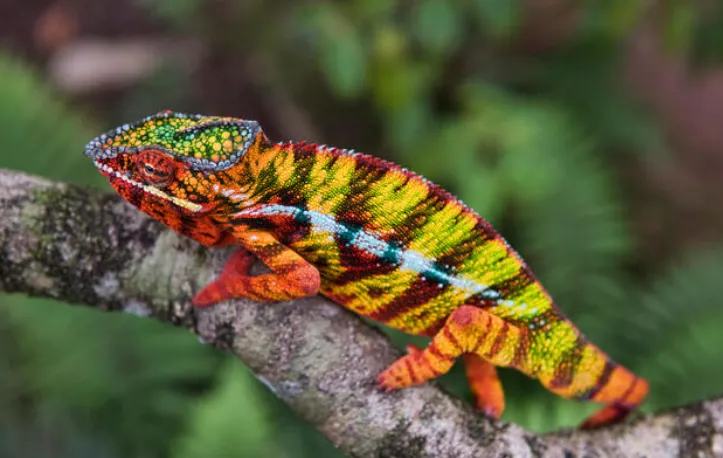
Diet and Nutrition
Being insectivores, their diet primarily consists of insects, including crickets, mealworms, and roaches. Regular calcium and vitamin supplements are vital for their health.
Health and Wellness
Like all chameleons, dehydration, metabolic bone disease, and vitamin deficiencies are common concerns. Regular check-ups with a vet who specializes in reptiles are recommended.
Breeding
After a successful mating, females will lay clutches of eggs in a humid and safe substrate. The number of eggs and incubation period can vary.
Conservation Status
Panther Chameleons face threats from habitat loss and the pet trade. However, efforts are being made in Madagascar to ensure sustainable practices and conservation.
Fun Fact:
A Panther Chameleon’s tongue can be as long as its body, allowing it to snatch prey from a distance in a fraction of a second.
Photo Gallery

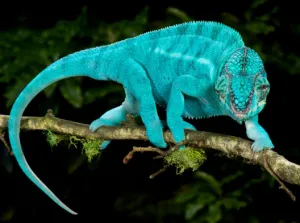
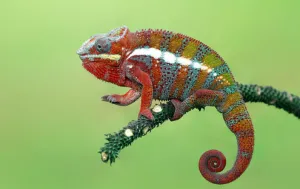
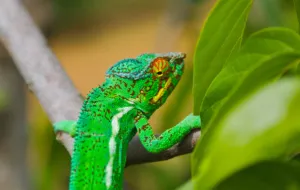
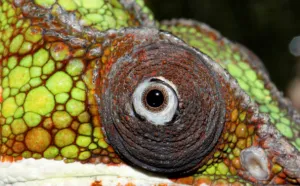

Check out the video below of a Panther Chameleon in the wild:
Related Profiles
- Veiled Chameleon
- Jackson’s Chameleon
Share This Profile:
3 Amazing Facts About Panther Chameleon
- Colorful Communications: Male Panther Chameleons often exhibit brighter colors when displaying dominance or attracting a mate. Conversely, darker or subdued colors might indicate stress or illness.
- Prehensile Feet: Their zygodactyl feet – two toes facing forward and two facing backward – make them expert climbers and graspers, well-suited for life in the trees.
- Solar Powered: Panther Chameleons often bask in the sun not just for warmth but also to absorb UV rays, essential for vitamin D3 synthesis, which aids in calcium absorption.
- Enchi Ball Python: A Unique and Stunning Morph of Python regius - March 27, 2025
- Emerald Tree Monitor: The Enigmatic Green Guardian of the Rainforest - March 26, 2025
- The Egyptian Cobra (Naja haje): A Fascinating Serpent - March 25, 2025
